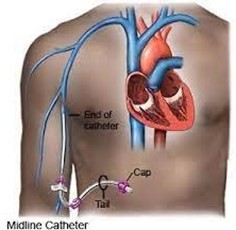The nurse is working on a cardiac unit with several patients who have intravenous access lines. The nurse identifies the following are considered central venous catheters: (Select All That Apply)
Midline catheter
Tunneled catheter
Non-Tunneled catheter
Peripheral IV
PlCC Line
Correct Answer : B,C,E
Explanation: Central venous catheters are catheters that are inserted through a vein in the chest, neck, or groin and then threaded through to a large vein near the heart. These types of catheters are used for long- term treatment and monitoring of critically ill patients.
A midline catheter is a type of peripheral IV catheter that is longer and extends into the upper arm, but it does not reach a central vein and is not considered a central line. Therefore, option a. is incorrect.
A peripheral IV catheter is inserted into a peripheral vein (e.g., hand, arm), and it does not reach a central vein, making it a peripheral line. Therefore, option d. is incorrect.
A tunneled catheter is a type of central venous catheter that is inserted through a small incision in the chest and then tunneled under the skin to a central vein. It is typically used for long-term treatment and is less likely to become infected than a non-tunneled catheter. Therefore, option b. is correct.
A non-tunneled catheter is a type of central venous catheter that is inserted directly into a central vein in the chest, neck, or groin. It is typically used for short-term treatment and is more likely to become infected than a tunneled catheter. Therefore, option c. is correct.
A PICC line (peripherally inserted central catheter) is a type of central venous catheter that is inserted through a vein in the arm and then threaded through to a central vein near the heart. It is typically used for long-term treatment and is less invasive than other types of central lines. Therefore, option e. is correct.

Nursing Test Bank
Naxlex Comprehensive Predictor Exams
Related Questions
Correct Answer is A
Explanation
Deep breathing or "diaphragmatic breathing" is a technique used to prevent recurrent pneumonia and improve lung function. During deep breathing, the patient is instructed to inhale deeply, expanding their lung volume as much as possible. This process is called inspiration.
Expiration, on the other hand, is the process of exhaling or breathing out air from the lungs. Intake refers to the process of taking in air or breathing in, while chest is a part of the body where the lungs are located.

Correct Answer is A
Explanation
Pulse oximetry is a non-invasive method of monitoring the oxygen saturation level in the blood. A normal range for oxygen saturation is between 95% and 100%. An oxygen saturation level of 89% indicates hypoxemia, which is a serious condition that can lead to tissue damage, organ failure, and even death if left untreated.
Therefore, the priority nursing action is to perform a respiratory assessment to determine the cause of the hypoxemia. This should include assessing the client's airway patency, breathing patern, lung sounds, and oxygen therapy if the client is already receiving it. The nurse should also observe for any signs of respiratory distress such as cyanosis, accessory muscle use, or difficulty breathing.

While it is important to document hypoxemia and report it to the healthcare provider, the priority at this time is to assess and intervene promptly to prevent further deterioration of the client's condition. Checking the placement of the pulse oximeter may be necessary if the reading is unreliable, but it is not the priority in this scenario.
Whether you are a student looking to ace your exams or a practicing nurse seeking to enhance your expertise , our nursing education contents will empower you with the confidence and competence to make a difference in the lives of patients and become a respected leader in the healthcare field.
Visit Naxlex, invest in your future and unlock endless possibilities with our unparalleled nursing education contents today
Report Wrong Answer on the Current Question
Do you disagree with the answer? If yes, what is your expected answer? Explain.
Kindly be descriptive with the issue you are facing.
